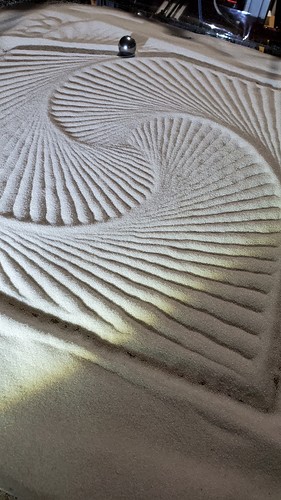Hey folks,
As a lark I build one of these using 24" shelf standards as my rails. I used corexy and a ramps 1.4 board for the motion control. 3D printed parts for just about everything else. And, so far, it’s working great! I think I’m going to switch from sand to baking soda to quiet it down. Wish me luck!
Jessica
Here are some more videos and images for my new CNC sandbox build. As I mentioned previously, the rails are simply 2" shelf standards bought from the hardware store for about $2 each. For those who don’t know, a shelf standard is one of those cheap metal rails with slots cut into it that you screw onto your wall and work with adjustable shelf brackets. The moving parts are just 3D printed PETG sleeves sized to slide over the rails with minimal friction. I also used lithium grease on the rails to help further reduce friction. The electronics are simple as well. I just used a cheap off-the-shelf RAMPS 1.4 board with an Arduino and a Raspberry Pi4 running Octoprint.
An obvious question is how long will the moving parts last before friction causes them to wear away and fail? Personally, I think they will last a long, long time. The machine moves slowly and the loads are minimal, so why shouldn’t they? Also, I printed the walls at .125" thick and 100% infill. That’s a lot of plastic to wear away before it fails.
One reason I took this approach was to simply see how cheaply I could build one of these. You save a lot of money if you eliminate all those bearings!
Jessica
Overview: https://youtu.be/hGUqDEO8Ju4
Y-Axis Slide: https://youtu.be/GpnDW3iGQXs
X-Axis Slide: https://youtu.be/6lJWd2nyki8
cool! thanks for sharing! it should last quite awhile as long as they have grease on the rails. I 3d printed to roller bearings for my spool holder over the summer. it gets used everyday. still rollin!
Are the imperfections in the design due to it being done in sand, or the shelf standards? Either way, I love the aesthetics of the precision of the overall design combined with the slight imperfections in the execution. Might have another project on my hands…
I love it!
Damn, you got my wheels turning now.
Thanks for the inspiration.
I like you’re apporach a lot @Jessica!
I suspect the sliders transmit less noise than bearings on steel tubes…The ZenXY is probably overengineered in that respect.
I think I’d use nylon rather than PETG, just because I think it has inherently lower friction, and I find nylon produces really robust 3d prints. I’d also use wax or a dry lube for the rails rather than grease, because in my world the grease is going to collect dust and dirt and dog hair, etc. (unless its fully enclosed…)
You have me thinking about modifying my ZenXY to eliminate the bearings…
Well, the imperfections could be from a lot of places… I’m still doing a lot of debugging! I was using 1/4" glass to support the sand. That was super loud as the sand ground against the glass! I later placed a layer of plastic between the glass and the sand which dropped the sound a bunch. I also added too much sand and the ball ended up bogging down. Then I tried 1/8" glass but the magnet pulled too tightly and caused issues. I later tried baking soda but that seemed too dense for the ball to pass through it well. I’m trying a 3/4ths ball now but I may switch to a 3/8ths to see how that changes things. All in all, it’s just a big experiment!
I’ll post files to thingiverse when I get time.
Jessica, welcome to the forum. This is awesome! Nice use of available cheap products. Now I HAVE to build a ZenXY. Maybe I should get better with my MPCNC first…
In this topic Jeffeb3 posted a YouTube video of a sand table build. The video author suffered through some of the same struggles you indicate here. One takeaway for me was the use of a felt pad on the bottom of the ball. the felt ought to significantly reduce noise, and the felt on the ball and perhaps on the magnet below would allow some adjustment in distance and therefore to magnet strength.
Some cool ideas in your build. I look forward to future updates.
